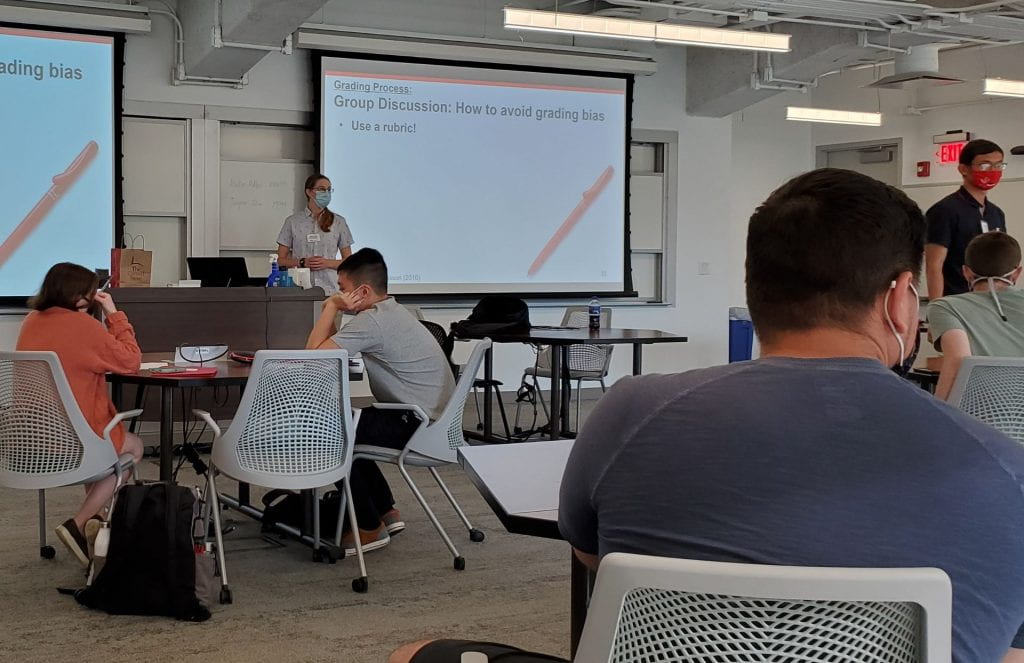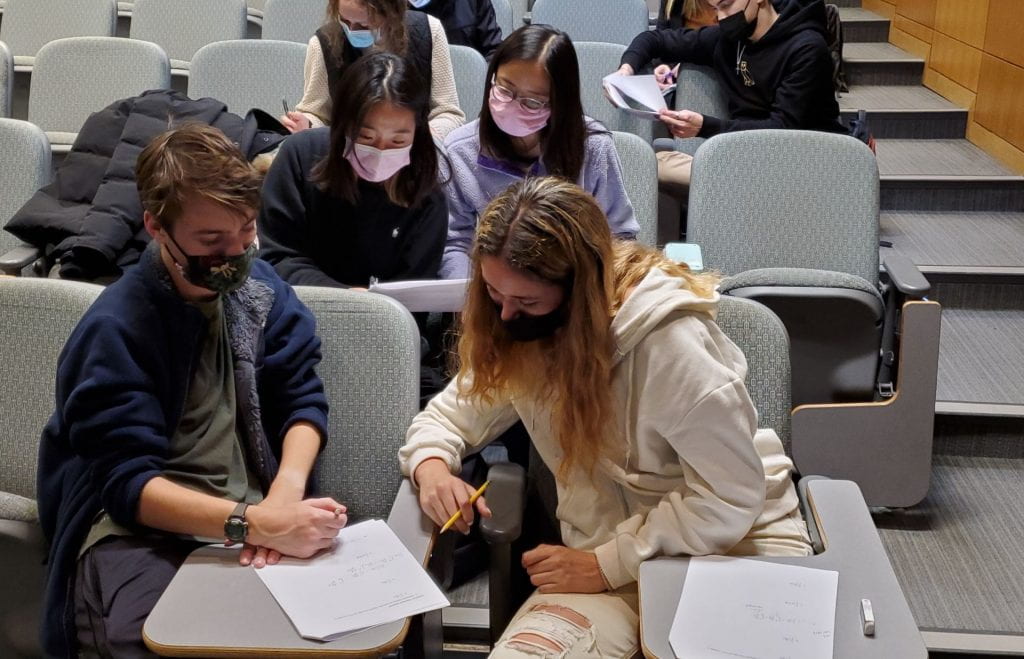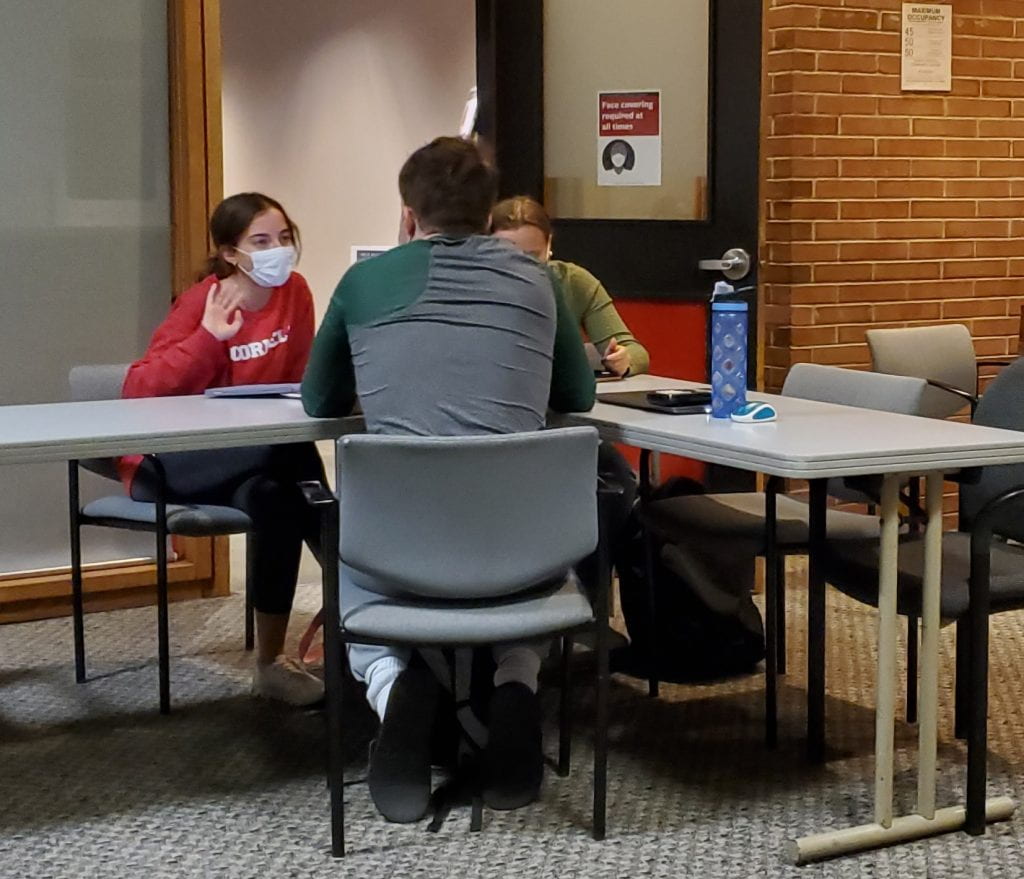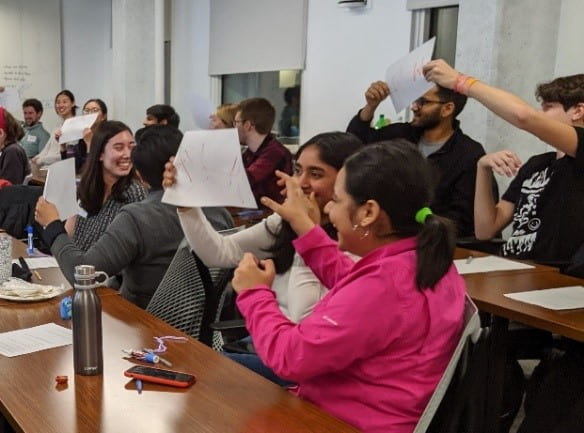
 As we know, collaboration does not typically happen by simply asking students to collaborate. Without structure, students familiar with the still-common passive forms of teaching often default to working independently, or occasionally cooperating with a peer nearby, and then only if they are confident and feel safe in a classroom. Creating the sort of inclusive collaboration that is most likely to improve learning outcomes is challenging, and requires structural scaffolding and diligence on the part of the instructor.
As we know, collaboration does not typically happen by simply asking students to collaborate. Without structure, students familiar with the still-common passive forms of teaching often default to working independently, or occasionally cooperating with a peer nearby, and then only if they are confident and feel safe in a classroom. Creating the sort of inclusive collaboration that is most likely to improve learning outcomes is challenging, and requires structural scaffolding and diligence on the part of the instructor.
Structure creates inclusive collaborative groupwork in a student-centered classroom. The key is how we understand and address ‘structure’.
Three components of structure should be considered in order to make effective collaboration happen: 1) Characteristics of the learning space itself and how they are used – “physical space”, 2) the development of community and inclusiveness among learners and between learners and instructors – “emotional space”, and 3) pedagogical choices and their implementation “pedagogical space”.
Structuring the physical space
Recently Colleges and Universities have begun to pay much more attention to the design of physical learning spaces. The two images to the left show classrooms that have been designed or updated for collaborative learning.
Thankfully, the options to teach in spaces that consider student collaboration, neurodiversity, and accessibility, are increasing. However, there are many remaining learning spaces that were designed for the traditional lecture format in which we must make the best of a bad situation. Further, and something less discussed in the literature and education blog-o-sphere, is that regardless of the quality of room design, effective group behavior is not ensured by grouping students in even the most perfect setting without ensuring the other forms of structure are in place. This post shares tips for each of the types of structure, and how to make the most of a tough classroom design situation!

There are many different room designs that are amenable to group collaboration. Key aspects of such classrooms are those seen in the images above. Students, when seated, are at small tables so that they face each other and have common working space. The room provides ample space for movement.
The worst case scenario for collaborative learning involves a room with attached seats, no aisle, and all seats facing forward toward a single area at the front of the classroom where a single projection screen is flanked by chalkboard (the only access to writing/collaborative space is this board). These spaces are very familiar in higher education! Here are some workarounds to support collaboration in these environments!

If the room is not at capacity you can brainstorm and prescribe seating arrangements.
A group of 4 in a ‘panel’ formation is not conducive to end members hearing and communicating with each other, and often the students default to work individually or in pairs at best.

When students are randomized into groups of 3 or 4, two students sit in the front row, ideally, with a seat between them and the writing desk of the empty seat raised between them. They can use the center desk as the collaborative writing surface (not pictured here). In this seating arrangement, students can face each other such that the one or two people in the row behind sitting side-by-side, make a physical group.

Another familiar seating situation in moderate sized classrooms is long tables, horizontal to the front of the room, or tables that create a ‘U’ shape for large group discussions.
Moving chairs from one side of the table to another or having students in one row of tables turn their chairs around, so they are seated on either side of the long table facing each other, is a relatively easy fix. In general, the instructor should be explicit and possibly show the class a diagram, or the common default is a ‘panel’ formation that does not promote communication among all members.
In a packed lecture hall, instructors can still work creatively to help students form small groups, but the easiest to implement is a paired working arrangement (think/pair/share), which can be very effective particularly if the partnering switches from one side of a student to another.
These are only the first steps to fostering inclusive, collaborative learning. Even in the most modern of classrooms, collaboration will only happen if both the emotional and the pedagogical spaces are prepared and monitored!
Structuring the emotional space
Much has been said about the importance of creating belonging in a learning environment to allow inclusion of all learners regardless of differences in personality, confidence, or other aspects of diversity that we need to celebrate. There is general agreement that this is the primary consideration from which all other scaffolding of the classroom climate flows. Getting to know each other in a classroom where the expectations for respectful interaction are clear (and ideally developed as a class) will allow trust to build, relationships to form, and engender willingness to work together and a desire to be accountable to one another

- Make an effort to learn students names, and have them learn each others name (and pronounce them correctly).
- Throughout the semester, include icebreaker activities – build common ground. ‘Identity affirming’ or ‘self-affirming’ icebreakers are those that promote students sharing aspects of who they are, and help create strong community.
- Encourage the sharing of pronouns and allow it to be voluntary. Instructors should consider sharing their pronouns to model the choice and explain why.
Structuring the pedagogical space
Structure assignments that require collaboration. The outcomes of the activity should require both individual accountability and collaborative interaction. Pedagogical choices should be articulated to students along with expectation for participation. Well considered learning objectives provide direction (for students and teachers!) and all these aspects of structure should be constantly monitored.

- Explicitly create groups through a simple, fun form of mixing students. In a pinch, counting off such that you end up with groups of 3-5 is easy. Mixing matters for inclusion, and having students work with different peers each activity helps create community in the large classroom throughout the semester.
- Clarify the learning outcomes for the group activity.
- Explain how the task involves both positive interdependence and individual accountability, and how you will assess each.
- Assign group roles or give groups prompts to help them articulate effective ways for interaction.
Best laid plans for knowledge construction using groupwork can fall flat in classrooms with the most modern designs. Indeed, technology, movable table units, and whiteboards on surrounding walls create an opportunity for effective groupwork! Yet even those settings can become ‘lecture theatres’ without building a community, intentionally grouping students, designing activities that benefit strongly from collaboration. Instructors should articulate and share specific learning objectives, rationale, expectations, and guidelines for collaboration. And finally, the key: doggedly, doggedly monitor, encourage, and interject just-in-time questions and information during the collaboration. This is hard work, but the learning outcomes of real collaboration are rewarding for students and instructors!